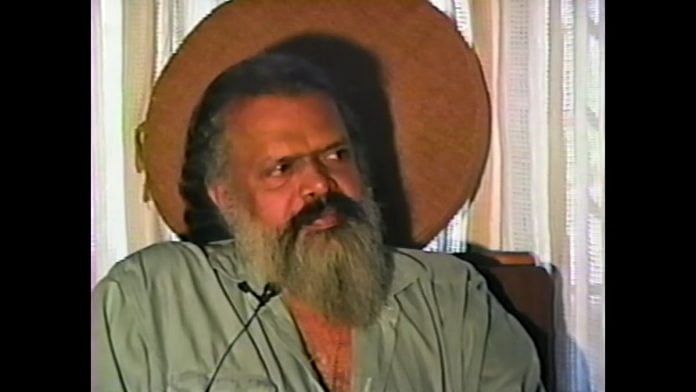New Delhi: Silence prevails in a shed where a dozen or so cows rest through the night. A sliver of light from a partly opened door falls on a body hanging from the rafters, swaying gently in the breeze. After a minute’s silence, the cows begin to moo, the dogs bark, and the rooster crows. The last words spoken before the camera pans to the grisly scene is: “You bloody sinner!”
The scene described above is the crux of the movie Chidambaram (1985), directed by Govindan Aravindan, popularly known as G. Aravindan. A pioneer of Malayalam art-house cinema, his death on 15 March 1991—when he was only 56 years old—came as a shock to the Kerala film industry.
A famed cartoonist, Aravindan, published a weekly series titled “Cheriya Manushaynum, Valia Lokavum (Small Men and Big World)” in the Malayalam publication Mathrubhumi during the 1960s and 1970s. Film critic Sasikumar Vasudevan writes, in the open-source encyclopedia Sahapedia, that Aravindan’s cartoons were a “path-breaking commentary on the social milieu in the late 60s and 70s in Kerala.”
Aravindan left behind a legacy of 11 films, one of the longest-running cartoon series, documentaries, and a history in theatre – highlighting the versatility of the individual who was awarded the Padma Shri award for art by the government of India in 1990.
He was never formally trained in filmmaking. Born to MN Govindan Nair, a lawyer, cartoonist, and satirical writer, he studied at University College, Thiruvananthapuram before joining the Rubber Board and travelling across rural Kerala.
Nature and spirituality in Aravindan’s art
In his films, Aravindan attempts to go beyond an individual’s five senses. He focuses on looking at things “beyond our reason” – a sixth sense of sorts. His adaptation of Kanchana Sita in 1977 led to claims of him being an ‘atheist’.
“I can never expect to be an atheist though I can’t say I believe in a God sitting in heaven. Concretely, I believe in supernatural powers, in the mystical – these phenomena are very real,” said Aravindan to well-known film critic Khalid Mohamed.
Both natural and supernatural find a place in his films. For example, the lush green hills surrounding Munnar in Kerala are home to one of Aravindan’s most commercially successful films – Chidambaram.
The movie delves into the questions surrounding the human experience – morality, religion, spirituality, guilt, and one’s inner conscience.
In 100 minutes, the plot delves into the lives of three principal characters – Shankaran (Bharath Gopi), Muniyaandi (Sreenivasan), and Shivakami (Smita Patil). Shankaran, an estate manager in Munnar and an amateur photographer has a close master-worker relationship with Muniyaandi.
Their relationship is seen in the close, claustrophobic rooms and offices of an estate in Munnar. Muniyaandi looks after the cattle present in the estate, dressed often in the drab khakis of government employees.
Real colour enters the often silent movie with the entrance of Muniyaandi’s new wife – Shivakami, from Tamil Nadu.
Aravindan’s craft is such that the movie, often accompanied by subtle sounds of nature, gleams with colour as Shivakami slowly gets used to her surroundings. As the scenes show Patil’s character interacting with the vibrant flowers of Munnar, Shankaran goes through a metamorphosis.
Genius in the silence
Aravindan’s movies demand attention.
The depth of his characters and themes in each film resonates with the intellect of the viewer.
Nature and spirituality become the central subjects in Aravindan’s art. As Shankaran in Chidambaram falls into alcoholism and guilt, Shivakami vanishes from the movie. And the scenes return to the drab colours of liquor dens and district clinics.
“I too, used to drink heavily once…Know how I stopped it all? I became religious. When the temptations came, I read the Bhagavad Gita,” said the doctor to Shankaran, in the hope of steering him away from alcohol and material vices.
The filmmaker’s belief system would often persist beneath the surface of his work.
“We tend to judge life with the help of our five senses. The man who said electricity could be drawn from water was considered a lunatic. It’s necessary to look beyond. My work doesn’t say this loudly or openly but the elements of this belief are always there, perhaps subconsciously,” Aravindan told Mohamed.
His first movie, Uttarayanam (1975), looks at the thwarted goals and dreams of young people in India through the story of one individual’s search for a job. The movie portrays the “degeneration” of the “nationalist hopes and ideals,” writes CS Venkiteswaran in The Hindu. Uttarayanam was released months before Indira Gandhi proclaimed the Emergency.
In Kanchana Sita, the filmmaker examines the ideals of justice and governance. He also made movies such as Thampu (1978), which looks at the arrival of a circus troupe to an otherwise sleepy village and the social dynamics that arise from it.
His last film Vasthuhara (1991) is about the Partition. Venkiteswaran notes that while looking at displacement and exile, the film also delves into delves into personal dispossession. In the varied and wide worlds Aravindan paints for the viewers, the search for things beyond one’s reason is consistent.
(Edited by Ratan Priya)



